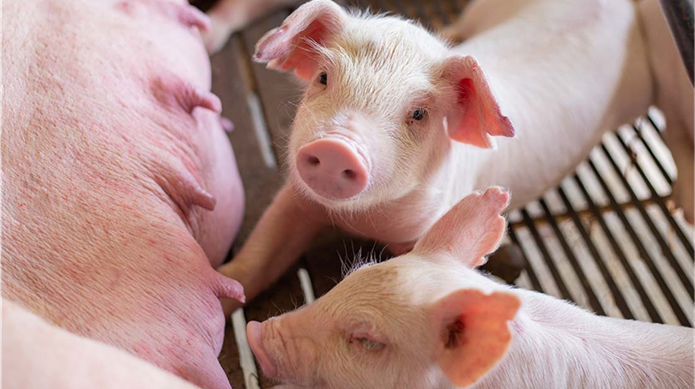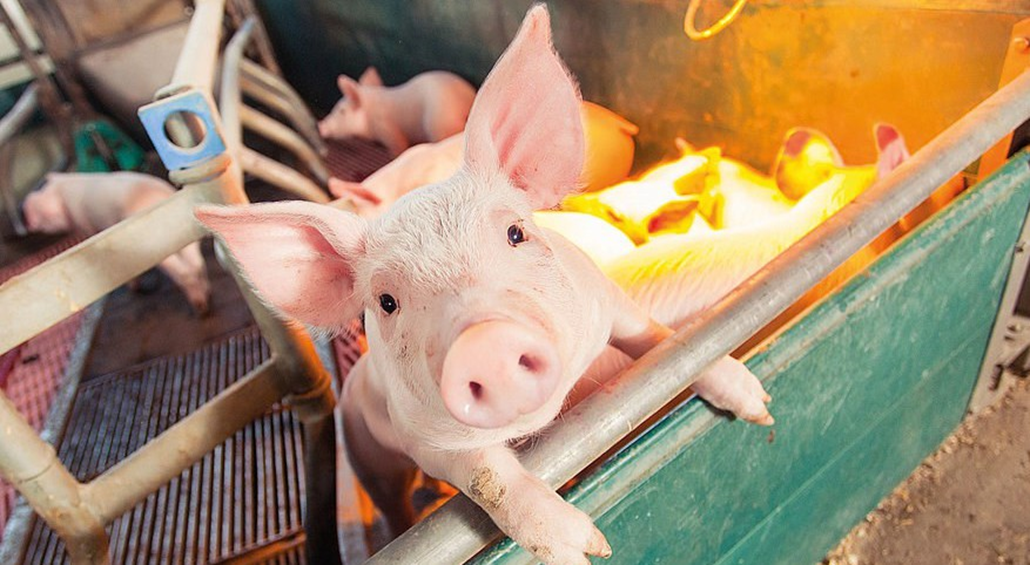E. coli in piglets, what is the big deal?
Colibacillosis is a bacterial infection caused by strains of Escherichia coli (E. coli), particularly in poultry and swine farming, but it can also affect humans. It commonly manifests as diarrhea and is a significant concern in newborn piglets. The impact of colibacillosis on piglets includes economic losses due to reduced growth rates, increased mortality and cost of treatment. It can also lead to secondary infections if not treated promptly. To control the outbreak of colibacillosis, effective management, good biosecurity, herd health and hygiene, as well as early intervention are crucial.

E. coli in commercial swine farming
Escherichia coli (E. coli) is a diverse group of bacteria, and while many strains are harmless, some can cause illnesses in animals and humans. In commercial pig production, E. coli can be a concern due to its potential to cause diseases such as colibacillosis.
Colibacillosis in pigs is often associated with strains of E. coli that can cause various clinical conditions, including diarrhoea, respiratory issues, and systemic infections. Factors such as crowded living conditions, poor sanitation, and stress can contribute to their spread within pig farms.
While it is important to realize the economic implications of these detrimental bacterial infections, more pressingly, we must consider the prevention and treatment of these challenges in the future. Widespread antibiotic use in animals, as well as improper usage in humans, can cause bacteria to develop resistance against antibiotics. This is referred to as antimicrobial resistance (AMR).
Responsible antibiotic use starts with a hands-on, targeted approach, which includes good management, early detection and appropriate treatments, to name a few. Before treatments can be administered, farmers and staff must recognize signs and symptoms of economically important bacterial infections, such as colibacillosis.
Types of colibacillosis
Colibacillosis, or E. Coli infection is one of the major diseases in the swine industry and it mostly causes illness and death in neonatal and recently weaned pigs. Post-weaning diarrhoea (PWD) which is commonly associated with enterotoxigenic E. coli (ETEC), is one of the most widespread porcine diseases, responsible for significant economic losses worldwide.
|
Type of colibacillosis |
Signs and symptoms |
Period |
|
Neonatal diarrhoea |
White/yellow/brown manure. Diarrhoea will appear 2-3 hours later after E. coli infection. Individual piglets or entire litter can be affected. Results in severe dehydration and high piglet mortality in the first few days of life. |
First 4 days after farrowing |
|
Pre-weaning diarrhoea |
Grey/white diarrhoea. Piglets become hairy and emaciated. Poor quality creep feed and piglets fed milk replacer can be affected more easily. |
The first week after farrowing to weaning |
|
Post-weaning diarrhoea |
Watery yellow or grey/brown projectile diarrhoea. Piglets become susceptible to infections of E. coli from the farm environment after weaning. Results in severe dehydration, poor growth and possible high mortality rates. |
The first few days after weaning |
|
Edema disease |
Characterized by sudden death or neurological signs (ataxia and tremors), in older and growing piglets. Highly fatal and caused by specific E. coli strains that produce toxins. |
5 days to 2 weeks after weaning |
|
Septicemia |
E. coli can also cause systemic infections in piglets, leading to septicemia. This will result in fever, depression and even rapid/ sudden death. |
Varies |
How does it work?
E. coli can cause disease through three main mechanisms: toxin production, invasion of tissues and cells, and spreading systemically. Certain strains of E. coli produce toxins that damage the lining of the intestines. The E. coli bacteria can invade and multiply within tissues of the intestinal tract, causing localized infection and disrupting normal gut function. Both mechanisms will lead to diarrhoea and dehydration. In more severe cases, E. coli can enter the bloodstream and spread to organs and cause septicemia. Septicemia will result in symptoms such as lethargy, fever, poor appetite and growth, organ failure and death.

Figure 1: Schematic illustration of the pathogenesis of post-weaning diar- rhoea in piglets. (ETEC: Enterotoxigenic E.coli)
Addressing E. coli on farm
As the saying goes, 'A good start is half the battle.' To ensure the health of piglets, it's crucial to provide them with the best possible beginning. Unlocking your animals’ natural capabilities is essential to promote a stronger, more resilient animal. This approach reduces the reliance on antibiotics and helps them better cope with future challenges.
The gastrointestinal tract (GIT) contains about 70% of the immune cells in the body. It is therefore imperative to keep the GIT of any animal as healthy as possible, as this will aid the animal in responding to disease challenges.
To maintain healthy animals with healthy immune systems, farmers can focus on three main pillars within their farming systems. These include Nutrition, Management and Health. Each pillar has its focus points - by taking care of these different aspects, this approach can provide a clear pathway to healthy and highly productive animals

Nutrition
Providing the correct nutrition will not only achieve good growth rates, but also keep a positive equilibrium between the animals’ diet, its microbiota, and the animal’s immune system. We can maintain this through:
- Maintain a consistent feed composition with high-quality, easily digestible ingredients.
- Implement efficient feed management for piglets, which includes allowing them ad-lib access to feed, providing multiple feedings throughout the day, offering high-quality creep feed, and ensuring that they receive the appropriate feed for each production phase.
- Ensure efficient feed management for sows to support good colostrum production (250g needed per piglet) and milk production.
- Take measures to prevent and manage mycotoxins in the feed, as they can disrupt the
gastrointestinal tract (GIT) integrity and cause a leaky gut. - Provide enough milk and creep feed to piglets pre-weaning and consider fostering piglets if necessary. After weaning, ensure there is sufficient feeder space (0.4m² per piglet) to promote good feed intake.
- Consider using low protein diets, organic acids or acidifiers, and essential oils or phytogenic feed additives in farms facing colibacillosis challenges.
Reduce feed-related stress by effectively implementing all the above points on the farm.
Management
On-farm management is arguably one of the most important pillars, as poor management can undo all the positives of good nutrition and good health. Management involves the handling and oversight of animals, water quality, housing conditions, and climate.
Water quality and intake:
- Monitor water intake daily as a decrease in water intake will be noticeable before a reduction in feed intake is seen.
- Ensure drinking nipples have the correct water pressure (0.6 litres/min for piglets).
- Ensure enough drinking space in each pen (at least 1 nipple per 8-10 piglets).
- Check that all drinkers work, and flush nipples before new animals arrive to remove stagnant/ old water.
- Implement water treatment (chlorine, hydrogen peroxide, filter or UV) to prevent pathogens from
accumulating in drinker lines and pipes. - E.coli can easily sneak into the farm through untreated water! Test water bi-annually.
- Water is the most important nutrient we provide to our animals as it directly impacts health, feed intake, growth and production.
Housing conditions:
- Provide appropriate ventilation and temperature control to minimize stress in piglets, (27°C-35°C optimal for newborn piglets). Cold stress is a trigger for this disease.
- Observe piglet behaviour daily and adjust temperature/climate accordingly, and always prevent overstocking.
- Manage flooring and bedding to reduce moisture and prevent pathogen buildup.
- Handle animals quietly and slowly - no shouting and chasing.
- Consider using E. coli vaccines for herds with persistent problems.

Figure 2: Piglets’ inadequate housing conditions with clean floors, sufficient heat and clean water will have a healthier GIT, better immunity and lower risk of contracting diseases like colibacillosis.
Health
Optimal nutrition pathogen-free environment and farm management are key drivers of animal health. Adequate intake of colostrum is important as it provides the piglet with maternal antibodies which help the piglet develop its immunity. Vaccinating can also be used to help develop the immunity of the piglet. Most importantly, good biosecurity protocols must be in place to keep pathogens out of the farms.
- Ensure a clear biosecurity protocol is implemented and understood by staff. This includes showering in/out, using clean PPE, using footbaths at each unit on the farm, and moving between houses in the correct manner (starting with the youngest and finishing with the oldest animals).
- Cleaning and disinfection protocols must be in place using appropriate cleaning agents. It is very important to let the area dry completely before introducing animals.
- Clear waste management should be in place that doesn't contaminate healthy animals, as well as designated hospital pens for sick animals, so that they may be separated from the healthy herd.
- Antibiotics must be used appropriately, on the advice of a local veterinarian. Each farm plays an
important role in the responsible use of antibiotics and in limiting the risk for AMR. - Recordkeeping is essential. Noting signs and symptoms can help identify the specific type of diarrhoea on the farm and may assist in spotting trends throughout seasons.
The current treatments of colibacilloses include the use of antibiotics, vaccines and use of Zinc oxide (ZO). New strategies are, however, needed as the use of substances like certain antibiotics and ZO will become more regulated and even prohibited in the future.
Genetic breeding of colibacillosis-resistant pigs is currently being investigated. Certain pigs do not have receptors for certain E. coli adhesins and are thus resistant to infection. Therefore, there could be a possibility to select replacement pigs that are more resistant to this disease.
Figure 3: Current treatments of colibacilloses
Conclusion
Often, the prevention and treatment of common diseases like scours or colibacillosis on swine farms are more reactive than proactive. These diseases prove to be very economically important and must be seriously considered and managed during the daily management of swine farms. Managing pigs should be done with the animal’s natural ability to remain healthy kept in mind. We can not only limit the occurrence of these diseases but also limit the reliance on medications. Improving animal health will result in more robust, higher-producing animals.
For more information on piglet management, water quality, feed recommendations and management, please contact your De Heus technical advisor - https://www.deheus.co.za/meet-our-team/.
